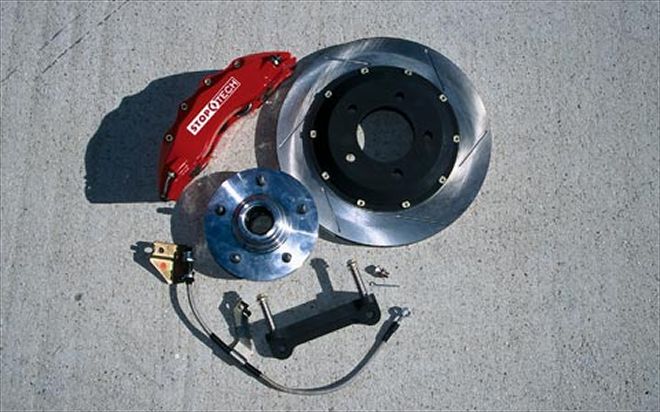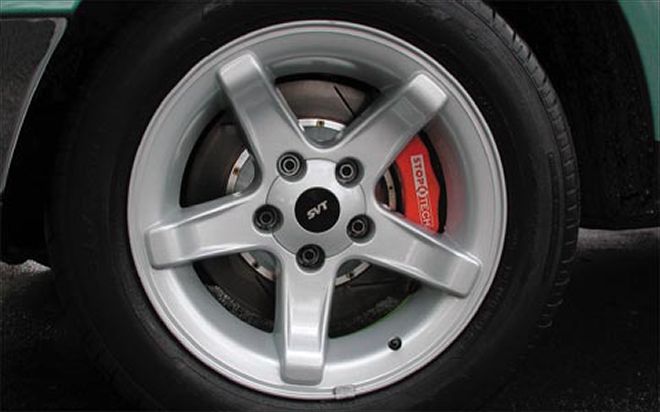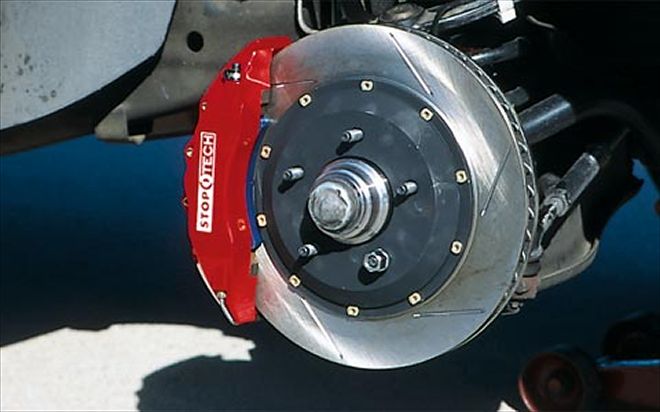Our Project Thunder, along with other Expeditions, touts just under a lofty 8000-lb-maximum towing capacity, and that's a lot for descending a 14-percent grade at 60 mph towing boats or dirt bikes and carrying associated gear. Conditions like these can cook brake systems in short order, something we don't want to see happen with the Thunder.
Reviewing the project steps we've taken thus far: Part 1 brought about a K&N filter, Borla cat-back exhaust, OZ Racing S/T Wheels, and Toyo Proxes tires; in Part 2, we focused on giving the big Expedition better handling by adding Eibach springs, Tokico Trekmaster R/T shocks, Hotchkis anti-roll bars, and offering the V-8 more grunt with JBA Shorty Headers and a new K&N FIPK2 intake; Part 3, power was the focus when Paxton was contracted to install its supercharger kit and tune the engine and related electronics. Now, in Part 4, we're faced with making the monster stop.

| 163 0208 Proj 01 Z
In stock configuration, our Thunder made 60-0 mph in 141 ft. The addition of larger Toyo tires helped it stop 3 ft sooner at 138. But we knew that any vehicle should stop as impressively as it moves--over and over and over.
To give its brakes the necessary grip, we turned to StopTech in Torrance, California. As if fate brought Truck Trend and StopTech together, the company had been planning to develop a six-piston caliper, two-wheel-drive front-brake system for Expeditions to complement its four-wheel-drive kit.

| 163 0208 06z 1998 Ford Expedition Suv Wheel
"Our systems are designed to withstand 950°, while the OEs are required to withstand only 750°," says Steve Ruiz, StopTech engineer. StopTech's four-wheel-drive Expedition kit pulled its test Ford 60-0 mph in just 122 ft. In comparison, a
Truck Trend test (Feb. '01) of a stock Expedition 4x4 came in at 142.
To demonstrate brake differences between StopTech and Ford, Ruiz joined us at the track with the Thunder and installed new brakes from Ford. This is where the lesson in brake technology comes in.
The best figure for the stock brakes from 60 mph was 127 ft, and the worst was 131. As we waited to see how much better the StopTech system would be, Ruiz went to work replacing Thunder's two-wheel-drive front stock stoppers. As it turned out, the best number StopTech provided was 127; however, it should be noted, that after seven full-on mash-the-pedal panic brakes, stopping distances were basically unchanged. Runs five, six, and seven with the StopTechs showed 127-ish consistently. We take this as proof of the heat-dissipation support the StopTech brakes provide over stock, a clear advantage when heavy-load towing and hauling come into play. Another advantage we found with the StopTech brakes had to do with pedal feel.
Motor Trend Senior Road-Test Editor Chris Walton commented the StopTech setup felt firmer and more confident.

| 163 0208 02z 1998 Ford Expedition Suv Wheel
Keep in mind when comparing Ford and StopTech numbers that sticky tires work wonders. Goodyear Eagle F-1s are road grabbers and a significant factor in why the truck stopped with large, Mercedes-like results with both systems. Also keep in mind these were prototype brakes designed just for Thunder, adapted from the 4x4 system--they were experimental. We're told StopTech has since done some reengineering and came up with what it considers a much better design for the two-wheel Expeditions because of the piston size.
While the SVT wheels created the first problem for StopTech because of offset issues, it figured out a way around them. Stock wheels are hard to match with aftermarket brakes for the same reason, and the OZs were probably a better choice for StopTech's original idea. However, the thinner design of the six-piston caliper over the four-piston allowed the necessary clearance to save the SVTs. Due to further development, StopTech will not market the six-piston design for two-wheel-drive Expeditions until mid-summer, though the four-piston is currently available.
Any time an undertaking of this magnitude is launched, it's good to know that anticipated and unanticipated challenges will happen. While this fact was ever evident in development, the Truck Trend/StopTech relationship with Thunder was a reasonably successful one, albeit a tad confusing. In the end, our Thunder was given a brake system we're happy with, thanks to the stamina of the StopTech crew. And it doesn't hurt that we could help StopTech in the creation of a better-than-stock system for other two-wheel-drive Expedition owners.
By the Numbers STOCK CONFIGURATIONAcceleration, 0-60 mph, sec9.1Quarter mile, sec/mph17.0/80.0{{{600}}}-ft slalom, mph{{{57}}}.0Braking, 60-0 mph, ft141
STAGE I MODIFICATIONSK&N air filter, Borla cat-back-exhaust power set, O.Z. Racing {{{Nova}}} S/T wheels, Toyo 285/60R18 Proxes S/T tiresAcceleration, 0-60 mph, sec8.8Quarter mile, sec/mph16.6/82.2600-ft slalom, mph58.0Braking, 60-0 mph, ft138 Stage I Cost$2946
STAGE II MODIFICATIONSEibach Springs, Tokico Trekmaster R/T shocks, Hotchkis anti-roll bars front/rear, JBA Shorty Headers, K&N FIPK2Acceleration, 0-60 mph, sec8.8Quarter mile, sec/mph16.6/82.2600-ft slalom, mph60.5Braking, 60-0 mph, ft138Stage II Cost$2006Total cost$4952
STAGE III MODIFICATIONS{{{Ford Expedition}}} 5.4L Paxton Supercharger kit, installation, and serviceAcceleration, 0-60 mph, sec7.0Quarter mile, sec/mph15.9/89.0600-ft slalom, mph60.5Braking, 60-0 mph, ft138Stage III Cost$4920Total cost$9872
STAGE IV MODIFICATIONSBraking, 60-0, ft127Stage IV Cost$3195Total cost$13,067
 | 163 0208 Proj 01 Z
In stock configuration, our Thunder made 60-0 mph in 141 ft. The addition of larger Toyo tires helped it stop 3 ft sooner at 138. But we knew that any vehicle should stop as impressively as it moves--over and over and over.
To give its brakes the necessary grip, we turned to StopTech in Torrance, California. As if fate brought Truck Trend and StopTech together, the company had been planning to develop a six-piston caliper, two-wheel-drive front-brake system for Expeditions to complement its four-wheel-drive kit.
| 163 0208 Proj 01 Z
In stock configuration, our Thunder made 60-0 mph in 141 ft. The addition of larger Toyo tires helped it stop 3 ft sooner at 138. But we knew that any vehicle should stop as impressively as it moves--over and over and over.
To give its brakes the necessary grip, we turned to StopTech in Torrance, California. As if fate brought Truck Trend and StopTech together, the company had been planning to develop a six-piston caliper, two-wheel-drive front-brake system for Expeditions to complement its four-wheel-drive kit.
 | 163 0208 06z 1998 Ford Expedition Suv Wheel
"Our systems are designed to withstand 950°, while the OEs are required to withstand only 750°," says Steve Ruiz, StopTech engineer. StopTech's four-wheel-drive Expedition kit pulled its test Ford 60-0 mph in just 122 ft. In comparison, a Truck Trend test (Feb. '01) of a stock Expedition 4x4 came in at 142.
To demonstrate brake differences between StopTech and Ford, Ruiz joined us at the track with the Thunder and installed new brakes from Ford. This is where the lesson in brake technology comes in.
The best figure for the stock brakes from 60 mph was 127 ft, and the worst was 131. As we waited to see how much better the StopTech system would be, Ruiz went to work replacing Thunder's two-wheel-drive front stock stoppers. As it turned out, the best number StopTech provided was 127; however, it should be noted, that after seven full-on mash-the-pedal panic brakes, stopping distances were basically unchanged. Runs five, six, and seven with the StopTechs showed 127-ish consistently. We take this as proof of the heat-dissipation support the StopTech brakes provide over stock, a clear advantage when heavy-load towing and hauling come into play. Another advantage we found with the StopTech brakes had to do with pedal feel. Motor Trend Senior Road-Test Editor Chris Walton commented the StopTech setup felt firmer and more confident.
| 163 0208 06z 1998 Ford Expedition Suv Wheel
"Our systems are designed to withstand 950°, while the OEs are required to withstand only 750°," says Steve Ruiz, StopTech engineer. StopTech's four-wheel-drive Expedition kit pulled its test Ford 60-0 mph in just 122 ft. In comparison, a Truck Trend test (Feb. '01) of a stock Expedition 4x4 came in at 142.
To demonstrate brake differences between StopTech and Ford, Ruiz joined us at the track with the Thunder and installed new brakes from Ford. This is where the lesson in brake technology comes in.
The best figure for the stock brakes from 60 mph was 127 ft, and the worst was 131. As we waited to see how much better the StopTech system would be, Ruiz went to work replacing Thunder's two-wheel-drive front stock stoppers. As it turned out, the best number StopTech provided was 127; however, it should be noted, that after seven full-on mash-the-pedal panic brakes, stopping distances were basically unchanged. Runs five, six, and seven with the StopTechs showed 127-ish consistently. We take this as proof of the heat-dissipation support the StopTech brakes provide over stock, a clear advantage when heavy-load towing and hauling come into play. Another advantage we found with the StopTech brakes had to do with pedal feel. Motor Trend Senior Road-Test Editor Chris Walton commented the StopTech setup felt firmer and more confident.
 | 163 0208 02z 1998 Ford Expedition Suv Wheel
Keep in mind when comparing Ford and StopTech numbers that sticky tires work wonders. Goodyear Eagle F-1s are road grabbers and a significant factor in why the truck stopped with large, Mercedes-like results with both systems. Also keep in mind these were prototype brakes designed just for Thunder, adapted from the 4x4 system--they were experimental. We're told StopTech has since done some reengineering and came up with what it considers a much better design for the two-wheel Expeditions because of the piston size.
While the SVT wheels created the first problem for StopTech because of offset issues, it figured out a way around them. Stock wheels are hard to match with aftermarket brakes for the same reason, and the OZs were probably a better choice for StopTech's original idea. However, the thinner design of the six-piston caliper over the four-piston allowed the necessary clearance to save the SVTs. Due to further development, StopTech will not market the six-piston design for two-wheel-drive Expeditions until mid-summer, though the four-piston is currently available.
Any time an undertaking of this magnitude is launched, it's good to know that anticipated and unanticipated challenges will happen. While this fact was ever evident in development, the Truck Trend/StopTech relationship with Thunder was a reasonably successful one, albeit a tad confusing. In the end, our Thunder was given a brake system we're happy with, thanks to the stamina of the StopTech crew. And it doesn't hurt that we could help StopTech in the creation of a better-than-stock system for other two-wheel-drive Expedition owners.
By the Numbers
| 163 0208 02z 1998 Ford Expedition Suv Wheel
Keep in mind when comparing Ford and StopTech numbers that sticky tires work wonders. Goodyear Eagle F-1s are road grabbers and a significant factor in why the truck stopped with large, Mercedes-like results with both systems. Also keep in mind these were prototype brakes designed just for Thunder, adapted from the 4x4 system--they were experimental. We're told StopTech has since done some reengineering and came up with what it considers a much better design for the two-wheel Expeditions because of the piston size.
While the SVT wheels created the first problem for StopTech because of offset issues, it figured out a way around them. Stock wheels are hard to match with aftermarket brakes for the same reason, and the OZs were probably a better choice for StopTech's original idea. However, the thinner design of the six-piston caliper over the four-piston allowed the necessary clearance to save the SVTs. Due to further development, StopTech will not market the six-piston design for two-wheel-drive Expeditions until mid-summer, though the four-piston is currently available.
Any time an undertaking of this magnitude is launched, it's good to know that anticipated and unanticipated challenges will happen. While this fact was ever evident in development, the Truck Trend/StopTech relationship with Thunder was a reasonably successful one, albeit a tad confusing. In the end, our Thunder was given a brake system we're happy with, thanks to the stamina of the StopTech crew. And it doesn't hurt that we could help StopTech in the creation of a better-than-stock system for other two-wheel-drive Expedition owners.
By the Numbers